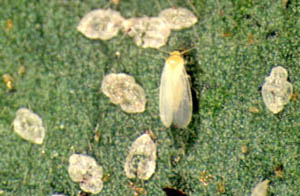Whiteflies

Adult whiteflies range from 1/16 to 1/8 inch in length. Most species resemble tiny white moths. Identification is easiest using the scale insect-like pupal stage.
Whiteflies have numerous hosts, including rhododendron and azalea, ash, dogwood, sycamore, sweetgum, honey-and black locust, barberries, redbud, roses, and herbaceous plants like hibiscus and verbena, among others.
When honeydew, sooty mold, or leaf yellowing is observed, examine the underside of leaves for feeding adult and immature stages of whiteflies. Ants foraging on leaves may indicate the presence of whiteflies.
Rake up and destroy fallen leaves. If honeydew or damage are objectionable, spray the underside of leaves with soap or oil to conserve beneficials. Remove heavily infested leaves. Predators and parasites usually keep these pests at low levels in the landscape. In the nursery application of systemic insecticides or IGRs may be required.
